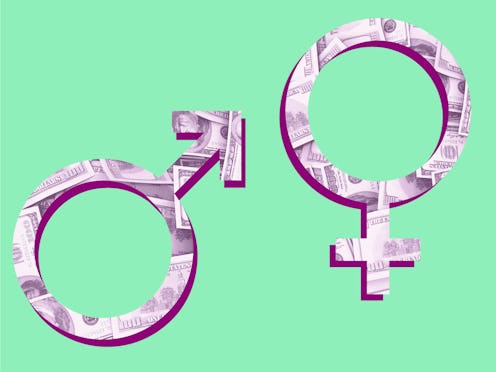
When we talk about the wage gap, it's common for people to bring up alternatives to the notion that women are getting paid less because they're women. Maybe it's because they work less, some say, or ask for lower salaries. But the Women, Work, And The State Of Wage Inequality report from Hired has proven unequivocally that women are getting lower offers than men through no fault of their own.
Hired, a site that matches tech workers with jobs, analyzed over 100,000 job offers, 15,000 candidates, and 3,000 companies on its platform, and the results combat a lot of common myths about the wage gap.
The Reality
First of all, the argument that blames the wage gap on women holding different jobs doesn't hold up. 69 percent of the companies on Hired are giving women lower offers than men for the same exact roles. On average, companies offer women three percent less than men for the same jobs, and some companies offer women as low as 30 percent less. Further suggesting that this is really about sexism — not women's own failures — the gap in offers was bigger for male-dominated roles like data science and software engineering.
Given this disparity, it's not too surprising that women have lower salary expectations. Among all the companies and job roles on Hired, women expect $14,000 less than men. This "expectation gap" was also much larger for male-dominated roles.
This might seem to explain why women are getting paid less, but Kelli Dragovich, Hired's SVP of People, tells Bustle over email to be wary of the women-don't-negotiate explanation for the wage gap. "Women should not and cannot be held solely accountable for closing the wage gap," she says:
The issue is largely systemic. For example, when women start with a lower salary at their first job, each promotion, raise or new job is often still less than their male counterparts who started off with higher compensation. Another problem is often employer’s unconscious biases that are hard to detect and even harder to regulate.
Potential Solutions
Instead of putting the responsibility on women to attain equal pay, Dragovich says, "the most powerful weapon for women working to rectify the wage gap is information."
Hired's report shows that the companies with the lowest wage gaps are small startups, which tend to have more transparency and therefore hold themselves more accountable for their treatment of employees. This is the logic behind a new policy in the UK that requires large companies to release records of what they've paid their workers.
Dragovich also says women and the companies hiring them shouldn't put too much weight on previous salaries, since this can perpetuate the wage gap. Instead, candidates can use a salary calculator to figure out how much their skills and experience are worth. Dragovich says Hired's users are often surprised by how much they're worth after doing their research.
In order to ensure equality in their workplaces, companies should invest in diversity initiatives and mentoring programs for underrepresented employees and standardize their salary offers. "Closing the wage gap starts at the people operations level by putting policies in place that make salary a non-issue," Dragovich says:
For my company, this means starting with a very clear compensation philosophy that applies third-party salary data holistically across the organization. As a result, we pay each individual according to the market rate for their skills and experience as opposed to their previous salary, so that we are not perpetuating past biases.
To get more women and minorities into the higher-paying jobs that tend to exclude them, there are also a number of recruitment tools that can partially remove gender and race from the employment process so that unconscious biases don't get in the way. The app Blendoor allows recruiters to search for candidates without seeing their race of gender, and the job-searching site Jopwell is catered specifically to black, Hispanic, and Native American job seekers. For its part, Hired just added two new features that can hide photos and names.
A Hopeful Future
Overall, though the wage gap persists, the picture isn't completely bleak. In fact, there's one group in which women are getting paid more than men: younger employees. Women with two or fewer years of experience are asking for two percent more than men — and getting seven percent more. The report hypothesizes that Millennials and Gen-Zers have learned to value gender equality and advocate for themselves. So, the wage gap definitely is real, but maybe it won't be for long.
Images: Caroline Wurtzel/Bustle; Giphy (2)